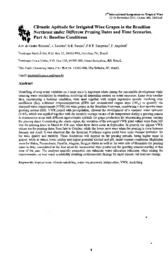Climatic aptitude for irrigated wine grapes in the Brazilian Northeast under different prunning dates and time scenarios. Part A: baseline conditions.
Climatic aptitude for irrigated wine grapes in the Brazilian Northeast under different prunning dates and time scenarios. Part A: baseline conditions.
Author(s): TEIXEIRA, A. H. de C.; TONIETTO, J.; PEREIRA, G. E.; TANGERINO, F. B. T.; ANGELOTTI, F.
Summary: ModeIling of crop water variables on a large scale is important when aiming for sustainable development while ensuring water availability in situations involving alI depending sectors on water resources. Long term weather data, representing a baseline condition, were used together with simple regression models involving crop coefficient (Kc), reference evapotranspiration (ETO) and accumulated degree days (DDac) to quantify the vineyard water requirements (VWR) for wine grapes in the Brazilian Northeast, considering a four months mean growing season (GS). VWR joined with precipitation, aIlowed the development of a vineyard water indicator (VWI), which was applied together with the monthly average values of air temperature during a growing season to characterize areas with different agro-climatic aptitude for grape production for winemaking process, varying the pruning dates. Considering the whole region, the variation of the averaged VWR pixel values were from 300 mm for pruning dates in March to 410 mm, when these dates occur in September. ln general, the highest VWR values are for pruning dates from July to October, while the lower rates were when the pruning is done between January and April. It was observed that the Brazilian Northeast region could have some thermallimitation for the wine quality and stability. These limitations wiIl depend on the pruning periods, being higher sugar in grapes, while in wines, lower acidity and higher potential alcohol and pH, under warmer conditions. Highlights were for Bahia, Pemambuco, Paraíba, Alagoas, Sergipe States as weIl as the west side of Maranhão for pruning dates in May, considered as the best areas for commercial wine production for growing seasons starting at this time of the year. The analyses spatiaIly presented, can subsidize water aIlocation criterions, when aiming for improvements on vine water availability avoiding environmental damage by rapid climate and land use change.
Publication year: 2011
Types of publication: Abstract in annals or event proceedings
Unit: Embrapa Semi-arid Region
Keywords: Clima, Deficiência hídrica, Disponibilidade de água, Grapes, Modelagem, Temperatura, Uva, Vinho, Vinho tropical, Viticultura, Water requirement, Água
Observation
Some of Embrapa's publications are published as ePub files. To read them, use or download one of the following free software options to your computer or mobile device. Android: Google Play Books; IOS: iBooks; Windows and Linux: Calibre.
Access other publications
Access the Agricultural Research Database (BDPA) to consult Embrapa's full library collection and records.
Visit Embrapa Bookstore to purchase books and other publications sold by Embrapa.

